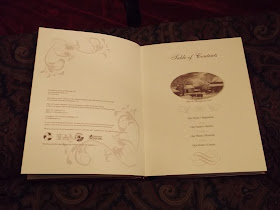Today’s post is a bit different than our typical Washington,
DC history tidbit or history mystery, but it is still related to house history:
rather directly as it turns out. A large
box arrived on Saturday from the State of Washington, and in it was something
I’ve been anticipating for a while now, after meeting Mike and Dan Hiestand
from Houstory.
We found each other via
my Twitter and their Twitter, and then met live following a conference and exhibit they were
represented at in Philadelphia – when is the last time you met a Twitter
follower in person?!
We had much in common beyond the love of old houses. After a tour of my own 1906 historic house,
we sat down and talked about their exciting new business at House History Book or 'Houstory.' These fellas had done their homework and
really investigated how to do it right – with the results being a fascinating
large book in which to maintain and preserve a history of a house: a Home
History Book.
I can’t tell you how many of my clients take the history of
their house (which we produce in a booklet format) along with them when the
house is sold…prompting the new owners to contact me for a history that we’ve
already completed (we tell them of course). The Houstory book is meant to convey with the
property, and I must say that its both a fantastic and creative idea, and I
suspect it will become very popular.
My own book arrived in a beautiful black box which is of
archival quality for storage of pictures and documents associated with your
house. It is embossed with their
copyrighted logo…inside was a felt slip tied with a bow, and inside that was
the book itself: about three inches thick, embossed with a front door design,
handcrafted in the USA with faux leather and our address engraved in a brass
plaque. Now that is impressive
indeed! I loved it.
But it is much more than a book, and browsing inside is
where you realize Mike and Dan have done their homework. Pages are all acid free and there is a
variety of page backgrounds you can choose from with screened backgrounds…as
well as different cover colors to choose from.
The opening pages have places to place the earliest known photograph of
your house, and other pages have areas for family information, guests,
renovations, and just about anything you might want to leave
for future
generations to enjoy.
Some pages are perforated so you can remove them when you’ve
added photographs so as to not expand the binding with the added bulk. You can really add whatever you want to
convey your own story, or what you have done to the house itself. As an architectural historian, its most
difficult to find out the last 30 years of history on any given house, simply
because that information often never makes it into the archives.
What to include? Think
of what you would want to know about the owners of your house 100 years ago,
they suggest, and I can’t agree more.
You can also include history that you have researched yourself, or
include the information revealed by hiring a historian like myself to include
in your book.
Another fun aspect is that you can have your house guests
sign in like a guestbook in a bed and breakfast. Imagine if you could read a list of everyone
that has stayed in your house over time: you’re beginning that tradition.
Each book comes with a stand to display upright, and each has a registration number unique to the book.
Its just a great book to record all those stories of what
you have done to the house, or what you gleaned from the previous owner or old
neighbor: write them down before you forget the names, dates, or items you want
to include. I’ve begun to use ours
immediately: do yourself a favor, and get one for your house as well.
April 19th Update: And, I can now pass along a coupon from Housestory for $75 coupon off your own book that appeared in their latest newsletter!





Great idea.
ReplyDeleteI'm planning to create a sort of house history book, but more of a "this is what's behind the walls" construction history book since the house has been gutted during my tenure. I look at my construction photos to remember where the wires, pipes and other stuff is before hanging a picture or whatnot on the wall.